-
Posts
1,261 -
Joined
-
Last visited
Content Type
Profiles
Forums
Events
Store
Posts posted by Andrej Stancak
-
-
David, sorry for changing your name. I apologise. I should not start writing in the morning before having my usual cup of coffee.
The possibility that the Baltimore area information in Lee Oswald's letters referred to a possible assassination attempt in Washington, DC contained in "The Man Who Talked Too Much" is important. I read Dick Russell's book last summer but obviously need to read again because I could not remember this part of Nagell's story.
There apparently were multiple plans to use Lee Harvey Oswald in whatever role in an assassination plot. According to Dick Russell, Lee Oswald knew that he has been participating in a plot but he did not know that it will be turned against him (although Nagell did warn him). He seemed to be ready to move to either place, Baltimore or Dallas, as requested. I understand that Lee did not to inform Marina about the Baltimore plan, maybe it was a short-lived plan, and it may have been replaced with Dallas too quickly.
I read Marina's testimony about their August and early September period in NO. Lee was speaking only about getting to Cuba, allegedly gathering information about cases of air plane hijacking. No mention about Washington, DC. He told her about his intention to travel to Mexico with an idea to get to Cuba, with a vague idea that Marina would join him there later. Lee must have been in quite a bad shape during September because no normal man would leave his pregnant wife and a toddler with an uncertain perspective of reunion, and travel abroad with an intention to get to an enemy country.
-
I wonder if Marina knew about the plan to move to the Baltimore area. Marina allegedly wrote to Ruth Paine and received an offer from her to live in Irving about in the first week of September. This does not show that Marina was in the loop as far as Lee's announced plan to move to the Baltimore area is concerned. Neither her Warren Commission testimony, nor her HSCA testimony mentioned Baltimore. It seems that no one asked Marina about the plan to move to Baltimore.
-
1 minute ago, Chris Newton said:
Texas

Thanks, Chris, much appreciated.
-
7 hours ago, David Josephs said:
And here is the letter stating his change in plans... no more Baltimore
Thanks, Joseph, for locating the original letters. Would you know what was the date of the later letter in which Lee wrote about settling in Dallas? Also, what could be the word (where my dots stand) in this second letter which I cannot interpret: "in Dallas, ..... for the time" . Could it be "just" ? This is important to understand whether Dallas was his temporary mission before eventually getting to "Baltimore area". If he understood that Dallas was only a temporary stop before getting to Baltimore, it would show that Lee Oswald's seemingly erratic steps were thoroughly planned.
-
The reference to Oswald mentioning Baltimore which I could only partially recall is from the book: "JFK and the Unspeakable" by James W. Douglas:
Also, on September 1, Oswald wrote to the Socialist Workers Party in New York City: "Please advise me as to how can I get into direct contact with S.W.P. representatives in the Washington, D.C.-Baltimore area. I and my family are moving to that area in October". [p. 155].
Thus, Lee Harvey Oswald mentioned Baltimore with quite a strong connotation (moving to that place with his family) only few days after Ruth Payne had visited Baltimore, Maryland and then Washington, D.C. on the next day. How could Lee Harvey Oswald come to the idea of moving to "Baltimore area" if not in reference to Ruth Paine's connections with that area. Could there initially be a plan to move Oswalds' to Baltimore to be honed by Ruth's sister and the plan then changed to moving them to Irving/Dallas?
-
On 2007-1-20 at 7:56 AM, Ashton Gray said:
Three days later, on Sunday, 24 August 1963, Ruth Hyde Paine traveled to Baltimore, Maryland, then the next day to Washington, D.C. "to stay with sister." And "sister" happens to be Sylvia Hyde Hoke—who has a CIA-blessed secret clearance from AID, and whose husband is John Lindsay Hoke.
What an interesting thread this is, and what an elaborate post by Ashton.
I do not have my notes at hand and may not remember correctly, however, did not Lee Harvey Oswald mention in one of his letters to FPCC or some other organisation that he had plans to move to Baltimore area? It would be in some letter from his New Orleans period, possibly from August.
How did "Baltimore area" come to Lee Harvey Oswald's mind? Could it be via the Ruth Paine channel?
-
I have checked Larry Sneed's book: "No More Silence" (1998) which contains Carl Day's memories of the assassination weekend. Unfortunately, the information about the exact moment at which he had initialised the rifle cannot be found in his account. However, Day did address the possibility that the rifle found on the sixth floor was different to the one submitted to the Warren Commission:
"Rumors were flying at that time. One had it that the rifle was deliberately placed there to implicate Oswald. I don't see how it could have been planted in the short time length there after the shooting (*). I do know that the gun that was delivered to the FBI and was at the Warren Commission was the same gun that I picked up on the sixth floor. It had my markings on it and was in my possession from the time I picked it up until I released it to Vince Drain. There's no question whatsoever that it's the same gun".
(*) Well, the rifle was brought to the sixth floor before the shooting. Day wrongly assumed it would have to be planted to the sixth floor only after the shooting which makes no good sense.
-
David:
I am not sure that you should be able to spot the markings shown in CE541, taken from a close-up view, on the same rifle photographed from a distance and with the sun reflections on it. Failure to identify the markings may be a natural result of low resolution, digitisation, lack of tack sharpness (motions of the rifle and the camera) and maybe other factors which I may not be even aware of. However, my doubts about the necessity of seeing the marks on Day's rifle may not be your doubts.
Day's signature on the rifle and on spent hulls are two different things. Thanks to Barry Krush's book (Impossible ...) and his YouTube video, it is quite clear that the spent cartridges were tampered with. However, there is not such indication for the rifle. The number of hulls needed to match the number of shots, and there should be evidence that the hulls came from one specific Mannlicher-Carcano rifle. I will search for more evidence as to when exactly did Lt. Day initialised the rifle.
In the meantime, what would be your explanation for having a different Mannlicher-Carcano on the sixth floor and in the Dallas Police Department later that evening? I just miss the point. The plotters wanted to trace the rifle found on the sixth floor to Hiddel/Oswald and would therefore not confuse things by first planting a wrong Mannlicher-Carcano rifle on the sixth floor which actually could not be traced to Oswald.
-
2 hours ago, Steve Thomas said:
Andrej, (or anyone else for that matter)
In his WC testimony, http://mcadams.posc.mu.edu/russ/testimony/bouhe.htm
George Bouhe said,
"... when I came in 1939, there were absolutely only three Russian-speaking people in Dallas and they were all married people, married to Americans, and so on. So I did not, so-to-speak, associate with any Russians that might have come or gone through Dallas from 1939 to about 1950.
In 1950, approximately, a great avalanche of displaced persons came to Dallas from Europe. Among these were probably 30, 40, 50 people, native of what I would say of various parts of the former Russian Empire. By that I mean to say that they were not all Russian. They might have been Estonians, Lithuanians, Poles, Caucasians, Georgians, Armenians, and such, but we did have one thing in common and not much more, and that was the language. (Russian I would guess)
It was a sort of constant amazement to me that these people, prayed God, for years before coming here while still sitting in various camps in Germany--they wanted to get to America, and if 1 out of 50 made a 10-cent effort to learn the English language, I did not find him."Does anyone know why there would be a sudden influx of immigrants from Eastern Europe into the United States in 1950?
Steve Thomas
PS: A regiment would have between 1,000 to 2,000 men. Without being in the same platoon, I'd be surprised if the SS Agent and Oswald knew each other.
Steve:
I am not a historian, however, I know a bit about the Eastern Europe satelites of the Soviet Union.
The strong immigration year 1950 comes logically from the developments in Europe after WW2. The war ended in 1945. Some central and eastern European countries were still democratic in the first months after the war as they were prior to break-out of WW2. Thus, these countries wished to reunite with their pre-war democracy. Unfortunately, due to the division of spheres of interests made at the Yalta conference in February 1945, the Eastern and Central European countries fell into the sphere of interest of the Soviet Union. This has been approved by other alies since the request by Soviet Union to have a shield of affiliated countries between Soviet Union and Germany appeared maybe reasonable at that time. The Soviets used the situation and installed their people, including KGB, into the governements of these countries. Although the initial free elections were not won by the Communist party in Czechoslovakia, the Communist Party was strong enough to be in the parliament and to take share in the coalition government. That governement was still a post-war government and people somehow did not fear Soviets enough because it was the Soviet Army which liberated the country, not the US. The US troops, General Patton's divisions, actually entered Czechoslovakia and could have liberated the capital Prague but they did not because they respected the results of the Yalta (Crimea) conference.
Once the communists had their share in a democratic governement, they took in the first instance the Ministry of Internal Affairs which controlled the state secret police, a Czech version of KGB. KGB supervised and trained the Czechoslovak secret police. In a quasi-democratic coup in February 1948, the members of the governement from the non-communist parties abdicated in protest of dirty tricks of the communists in hope of new elections which would end the communists' presence in the government, but which proved to be a fatal error. The now majority communist goverment, controlled by the Soviet communists, abolished the free elections, the right of free speech, dissolved the opposing political parties, abolished the right to travel abroad and return to own home country, nationalised the private enterprises and properties, and also exchanged the currency so that those who were rich before the war turned now to be equally poor as anyone else. People of holding non-communist political views weer jailed and forced to do low-qualification jobs (e.g., a medical doctor became a window cleaner).
Those who lost their enterprises or properties, those who ended up in jail after the coup, and those who suffocated under the new regime, wanted to flee the country desperately. This was still possible during the first months of 1948. These people usually ended up in the US bases in Germany. It took months, maybe a year or two, to sort out the asylum visa to the US. After coming to US, the exiles may have first arrived to New York, and only after few months they would find the right place for themselves. Thus, 1950 is the year where logically a surge of immigrants from central and Eastern Europe could be expected in Dallas.
Each Eastern or Central Europe country had a bit different scenario of their turn-over to communism but the end result was the same, and by 1948 there was already a block of now communist alies around the Soviet Uninion. Some countries, such a the Baltic states, were simply ingested by the Soviet Union.
After some more 10-15 years, there was a young American President whom the people in the Eastern and Central Europe countries viewed as someone who would likely break down the communism by proving it completely unnecessary as the US suddenly were not a threat. It is an irony that one of the potential reasons for killing President Kennedy was that he had been soft on communism. If President Kennedy would be able to complete his work, he would actually be the biggest threat to the communism as the regime lived from fear of the U.S. imperialism.
-
George:
your theory uses several "ifs". If just one "if" falls out, the whole construction would crumble. It will be interesting to see if your theory fares better with other members of this forum.
As per the date on the rifle, I do not think that the date 22/11/1963 was on the rifle and do not know whether the date was actually needed for maintaining the chain of posession. However, even the date could have been faked if you once admit that Officer Day had scribbled his name on a different rifle and on a different occassion and not whilst investigating it on the sixth floor.
-
George:
thanks for your explanation. I read it, understood, but do not find enough conclusive evidence for your theory. Your theory assumes that the bullet causing the back wound was the same found on a stretcher in Parkland. I thought that this magic bullet has not been fired during the assassination at all. Although the back wound theoretically could be caused by a bullet arriving from Daltex, it is more likely that the bullet fired from Daltex was not the same as the one found on a stretcher.
The angle of the back wound has been probed during the autopsy, to my knowledge, and it was a shallow wound of 1-2 inches and had an angle of 45-60 degrees. As it was that shallow, could it be fired from a high-powered rifle? The angle: authors Shaw and Harris in their book "Cover-up..." place the shooter of this shot to the west corner of the Depository roof. Just to point out that the locations of the shooters vary in different theories.
We agree that there were multiple shooters, but who knows for sure which shot came from which direction?
Could you please explain how Day's signature occurred on the rifle which is in the National Archives? I assume that the signature is there if Belin and Day were looking at it during Day's testimony, however, I myself did not check the rifle itself.
-
Joseph:
I have tried to analyse Day's rifle to spot the details you mentioned. I did not find any markings, however, the markings mentioned in your post would overlap with the burned out parts of the metal, (particularly "CAL 6.5") and the the middle part of the spot between two burned out columns which should contain "6" of "AL" is not a uniform grey, but it is just too blurry to determine whether there is or not a meaningful symbol there.
Anyway, I am copying the relevant part of the original CE541. The details on that rifle are not really conspicuous in the unprocessed picture and might also get unrecorded in a photograph if the rifle CE139 would be photographed under the same conditions as "Day's" rifle was.
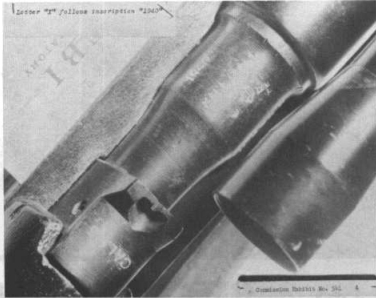
Officer Day marked the rifle found on the sixth floor. It should be possible to find out by a visual inspection of the rifle itself if his scribble is where he said he has put it:
Mr. BELIN. I am going to hand you what has been marked Commission Exhibit 139 and ask you to state if you know what this is.
Mr. DAY. This is the rifle found on the sixth floor of the Texas Book Store at 411 Elm Street, November 23, 1963.
Mr. BELIN. What date?
Mr. DAY. November 22, 1963.
Mr. BELIN. Does it have any identification mark of yours on it?
Mr. DAY. It has my name "J. C. Day" scratched on the stock.
Mr. BELIN. And on the stock you are pointing to your name which is scratched as you would hold the rifle and rest it on the stock, approximately an inch or so from the bottom of the stock on the sling side of the stock, is that correct?
Mr. DAY. Yes, sir.Actually, one of the panels in CE541 shows what could be "DAY" on a rifle, however, I am not sure.
If Day's name is on the rifle stored in the National Archives, it would be hard to accept that the Mannlicher-Carcano rifle carried by Day was not the same as the one in the National Archives. Besides that it would be a criminal offence to alter evidence, such manipulation does not give any good sense. The rifle was planted in advance of the shooting with the purpose to be found on the sixth floor, and to trace it to Oswald. Why would someone place an identical copy of Mannlicher-Carcano on the sixth floor just to replace it later with C2766?
-
Gentlemen:
the Mannlicher-Carcano rifle was the crucial evidence against Lee Harvey Oswald. As a conspiracy theory researcher, I posit that it has been planted on the sixth floor and maybe never used to shoot at the President. I do not know if there were shots from Daltex, and if they would be fired from another Mannlicher-Carcano rifle.
The one thing I dispute here is that the Mannlicher-Carcano rifle found on the sixth floor (and there might have been also a Mauser rifle there) was not the same we see Carl Day carrying on Elm Street, and not the same which has been displayed to Warren Commission and is now in the National Archives.
The apparent differences between the rifle carried by Carl Day and the rifles we see in various official pictures are only due to the fact that each photograph of the same rifle was taken from a different view angle and having the rifle orientated slightly differently.
The picture below shows the Mannlicher-Carcano rifle in Commission Exhibits 139 and 1303. It is the same rifle, however, it is has been photographed on different occasions. A rifle is typically placed on a white blanket on the floor, and the photographer leans over the rifle and takes a snap. One can take the picture of the rifle even without leaning over it. Thus, the photographs of the same rifle will offer different proportions and locations of the scope if the photographs are equalised relative to the length of the rifle.
Please see here how the rifles in CE 139 and CE 1303 differ in apparent locations of the scope and even of the trigger. However, it is one and the same rifle. Or would someone assume that the rifle CE139 has been substituted with a different rifle in CE1303? I have also added the rifle scanned from Killing of A President for comparison.
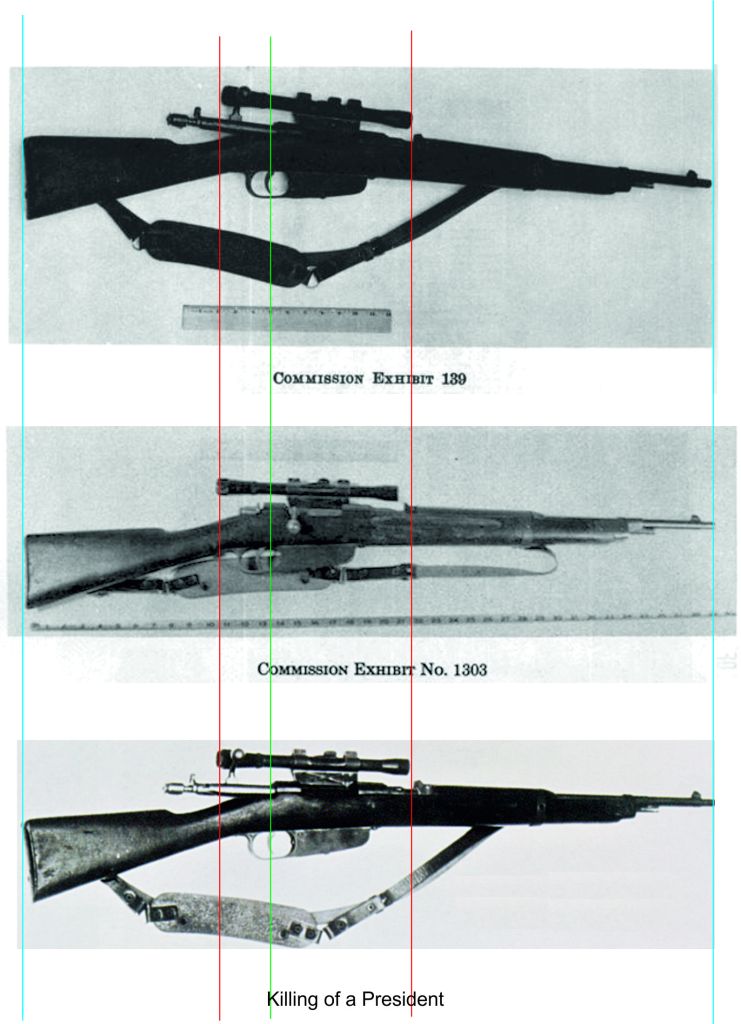
The conspiracy theory researchers have a special duty to differentiate accurately what evidence is valid and what not, and to protect the valid evidence else the case will be destroyed. A serious and painstaking work should be done first to explain inconsistencies such as this by natural causes and only admit falsification if doubts continue in spite of all attempts to explain anomalies by natural causes. This is the reason I stepped in into this thread.
-
Alberto:
I think you have not understood anything what I have tried to indicate in my posts. I leave you ruining your name ad libitum further.
-
The next illustrations may shed some light on the two rifles problem.
The figure below shows the scanned picture of the Mannlicher-Carcano found on the sixth floor. It was scanned from the book "Killing of A President" by Robert Groden. The panel below shows my 3D model of the Mannlicher-Carcano rifle made based on the photograph above. The bolt is open in this picture, and so it is in my model.
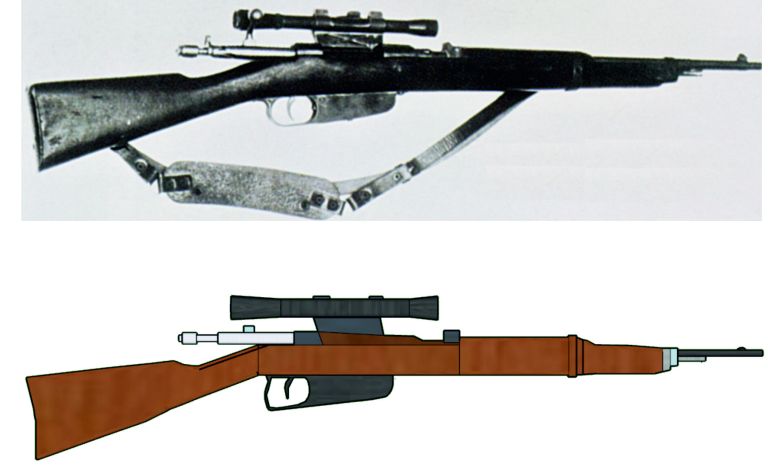
You may agree that the model matches the template photograph in all man features quite well.
The next two pictures show Officer Carl Day carrying the Mannlicher-Carcano rifle found on the sixth floor. The model of Mannlicher-Carcano shown in the figure above has been reoriented carefully to match the rifle held by Carl Day. The two pictures differ only in the strenght of overlaying.
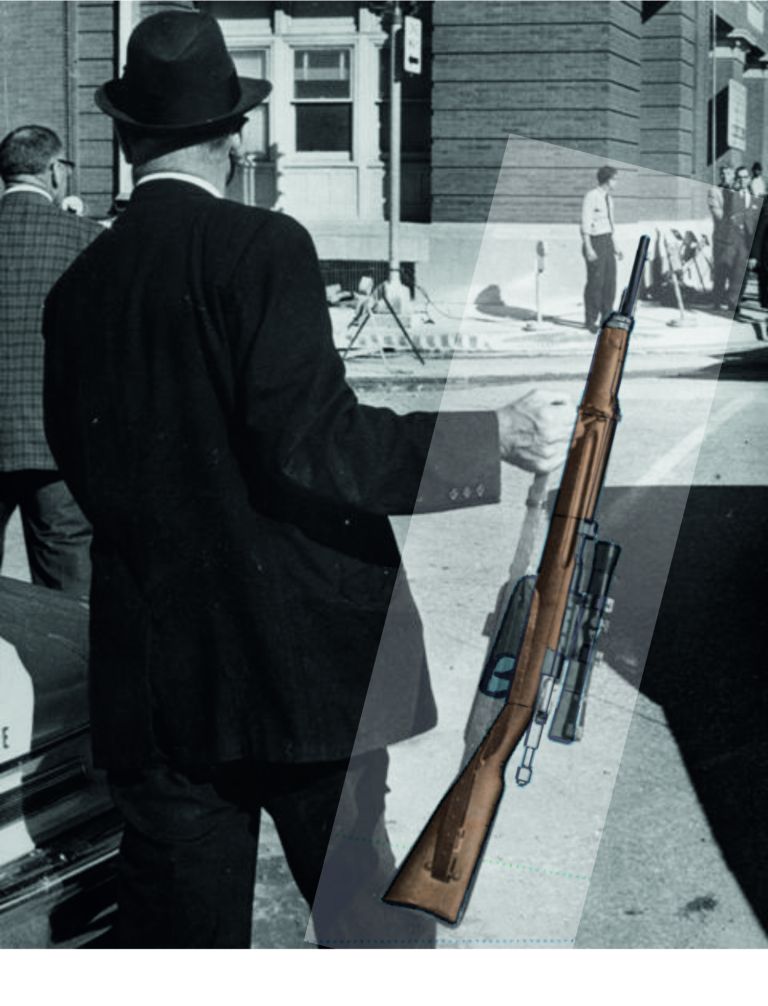
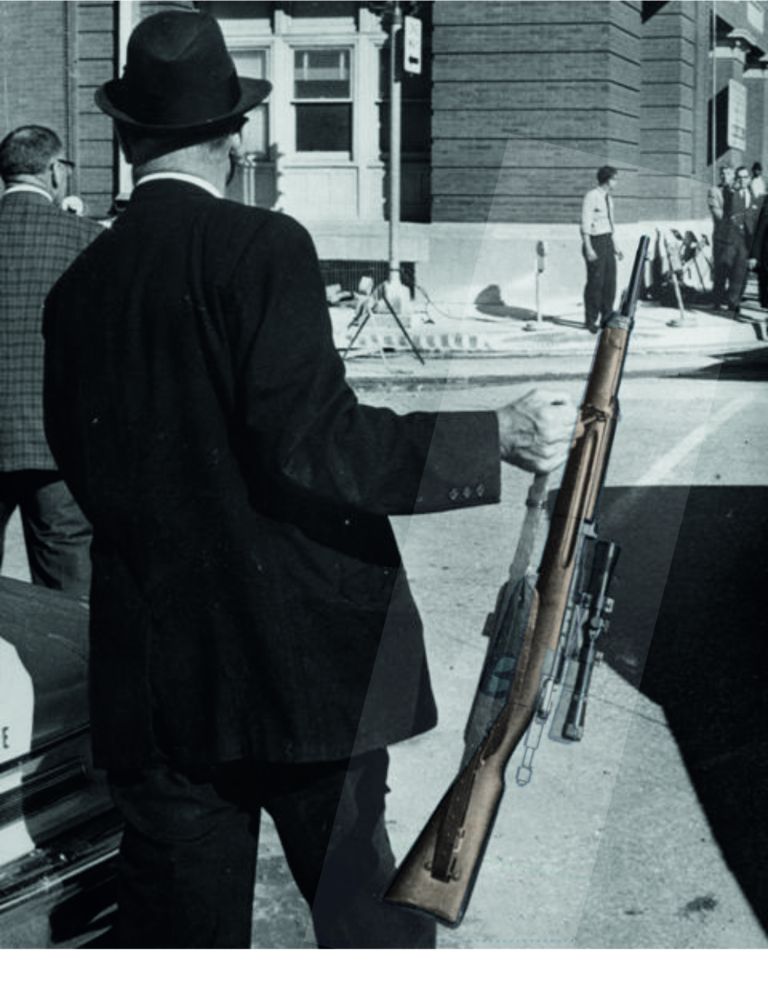
I hope that these pictures have cleared the issue as to whether the rifle carried by Carl Day was the same as the one stored in the National Archives. Naturally, one can argue that the gun shown in Groden's book was also different from the one in the National Archives.
-
Alberto:
how do you know that the axis of the rifle deviated from the vertical plane (perpendicular to the ground) by no more than 10 degrees? I would say that the rifle is inclined at an angle between 20 and 30 degrees (front-to-back), and it is also displaced to the left. Have you measured the azimuth and elevation of the TSBD rifle?
Further, it is not only the inclination of the rifle but also the view angle which can alter the proportions of the rifle. Please see my windmill example. In the original photograph, the rifle was not shot at the same view angle as the other one (Commission Exhibit), it was shot from a relative right and top vantage point. The view angle and the inclination of the rifle (and the distance and the focal length effects) interact, and it is therefore difficult to say how the proportions of the rifle would change if it is photographed in a real life situation on street compared to the photograph taken in the laboratory settings.
I was mentioning Mannlicher-Carcano rifle in Daltex building in response to George's post. Would you please explain the reasons for changing the rifle carried by Day (obviously brought down from the sixth floor) with another Mannlicher-Carcano rifle, without even ensuring that the lengths of the two rifles matched? Are there any types of Mannlicher-Carcano rifles which would differ in their lengths by 8 cm, which would explain the length difference in the rifle found on the sixth floor and the one stored in the National Archives? Any photographs of rifles coming from different production lines?
-
To at least point to the problem of the view angle, I am posting one more example. It is a windmill wheel. The left panel, the wheel is shown flat in an ideal front view. All leaves are of equal lengths as one would expect. The right panel shows the same wheel viewed from a different angle, as if the observer were viewing from a vantage point located at the top-right, similar to the photograph in which Officer Day carried the rifle on Elm Street, holding it by the strap. The leaves, although physically identical in their lengths, appear to be very different in the right compared to the left panel.
This example illustrates the problem (3) in my previous post. I hope this helps.
A front view. A view from top-right.
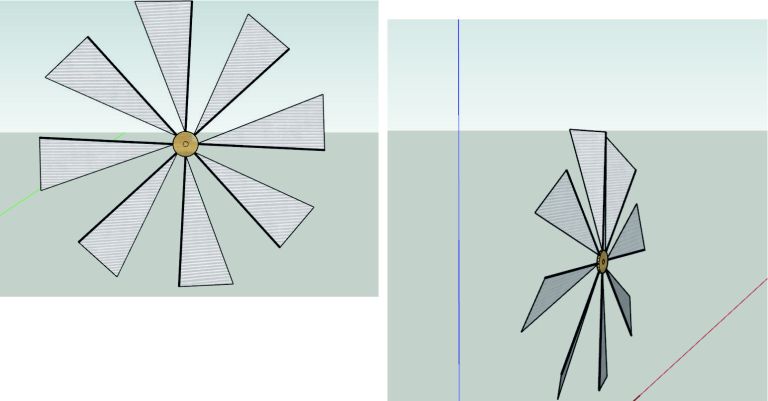
-
George:
thanks for your explanations of the motives for manipulating the identity of the rifle. I am also backing up a conspiracy theory of the assassination, however, now I see that I am only a weak cup of coffee compared to the heavy-weight case of conspiracy presented here by Alberto and others.
However, I may well be wrong and you may be right. My point is that it is necessary to get to the bottom of the problem.
1. Considering a tampering with the rifle which is in the National Archives, it is necessary to get exact measurements of that rifle and scope lengths by inspecting and measuring them there. Only then we will know what rifle is in the Archives. Showing a low-quality photograph and assuming it is the rifle in the Archives may be wrong. As a minimum, a certified picture of the Commission Exhibit showing the rifle is necessary.
2. All photographs showing Officer Day carrying the rifle on November 22 need to be analysed to be sure that there are no variations in the length and proportions for that rifle.
3. A study of effects of camera view angles, and inclinations/rotations of the rifle on the relative proportions of a rifle is necessary.
4. An overview and pictures of all known versions of Mannlicher-Carcano rifles needs to be provided, and it is necessary to show that the allegedly two rifles belong to different production lines.
5. Are there any testimonies, comments or remarks from the period of the assassination supporting the rifle substitution?
I am sorry for not being able to do this work as I am involved in other time consuming JFK projects, however, I would hope that the advocates of this intriguing theory would be willing to address the points listed above.
On a more trivial note: Why would it be necessary to use another junk Mannlicher-Carcano rifle in Daltex? Why not to use a high-quality rifle for the real shooting (e.g. with sabot) ? Eliminating bullets and planting ones matching the Mannlicher-Carcano rifle found on the sixth floor would be less risky than exchanging the rifles. I guess this is what happened: bullets got lost in Parkland and Bethesda, and one pristine bullet was planted. If the exchange of rifles happened as you suggest, it would be the FBI having the Daltex rifle in their possession prior to the shooting, meaning the FBI would be planning the shooting from Daltex and exchanging the rifles later in advance. The Dallas Police Department, e.g., Lt. Day, would certainly spot some 8 cm difference in the lengths of rifles sent to and returned from the FBI. The FBI would be in the hands of the DPD. However, it was exactly the opposite: the FBI stormed the DPD after the assassination since they believed that some members of the DPD had something to do with the shooting . Does your scenario still sound realistic?
-
Alberto:
would you please post the original photograph from which you extracted the rifle. It may have been one of Allen's photographs but I am not sure. It is important to see the rifle as originally displayed to know how twisted/inclined it was.
It is a tricky thing to derive too a detailed information from the old photographs. Factors such as camera lens focal length, view angle, the factor of perspective, and an exact positioning of a rifle are of importance. The interaction of these factors may yield unexpected results. To be sure that the two rifles are not identical, both items should be photographed with the same camera and under identical conditions which I know would be difficult to achieve if these were two different rifles ...
On a more general note: are you suggesting that the rifle which is in the National Archives is not the one which was brought down from the sixth floor? Is there actually any Mannlicher Carcano rifle measuring only "54 cm" ("46 cm") which is mentioned in your first post? Why would anyone do this manipulation? To whose advantage would this be? And what about the rifle which was shown later that afternoon at the Dallas Police Department - was it also a substitute rifle?
-
9 hours ago, Ernie Lazar said:
RECENT ARTICLE published in Independent Journal Review
U.S. Army Ranger Marty Skovlund Jr. served three tours in Iraq, and two in Afghanistan. He came from a unit that specializes in hunting down high-value targets.
In his last two deployments, he leveraged technology and targeting methodology to find high-value leaders within Al-Qaeda and the Haqqani Network.
In the History Channel's new show “JFK: Declassified,” Skovlund is working on a whole different kind of hunting now. Along with a CIA and LAPD veteran, Skovlund is part of a team investigating whom Lee Harvey Oswald, the man accused of killing President John F. Kennedy, might have been working with.
The team is acting on recently declassified files surrounding the historical assassination.
Independent Journal Review talked to Skovlund about the show and what viewers can expect to see.
Skovlund said:
"The three of us go and do an active investigation on the declassified documents surrounding the JFK Investigation. The investigation starts in Mexico City, Mexico, where Oswald met with the Soviets six weeks before shooting Kennedy. Think about [it] like this. If I were to go over and meet with ISIS, and six weeks later I returned to assassinate the President of the United States, it's worth looking into."
Some of the other cities that the show takes place in are Moscow, Dallas, New Orleans, and Miami.
Skovlund addressed how “JFK: Declassified” is not a show that promotes any conspiracy theories:
“We ignored all the conspiracy theories and look at the verifiable things like the release documents and investigated them like you would investigate a crime. The active investigation took about two months. “We know that Oswald pulled the trigger. But was he a lone wolf like they portrayed him to be? By going back and retracing his steps, and by implementing our skill sets into the investigation, we fill in the gaps the best as we can. If he met with this person did that have anything to do with the assassination attempt or was that pure happenstance,” Skovlund said.
Things got really interesting when Skovlund told IJR they talked to people who were in some way tied to the event 54 years ago, though:
"You're going to hear people in history that have never been on camera before. There are even times when we are in literal physical danger. You would think that 50 years later it would be easy to talk to people or find these we are looking for. There are a lot of people alive today that is actively trying to protect secrets surrounding the assassination. There are people still actively avoiding press and media. And they are acting like it happened yesterday. I didn't expect that much pushback. They were passionately against any exposure. These were people involved in one way or another with one part or piece of what we are investigating."
“JFK: Declassified” premiers on the History Channel on April 25 at 10/9 CT.
Ernie:
would you please post a summary of the "JFK:Declassified" if you were able to view it for those of us who do not have access to the US TV programs.
-
14 minutes ago, Chris Davidson said:
Andrej,
If Carl Jones was looking eastward in Altgen's 6, what would be the next event/sound that would cause him to look westward?
Answer this question and you might begin to understand the Myer's frame sync deception.
Well, it would be a gun shot coming from the west, wouldn't it?
I am not sure in my previous guess that frame 1 in Wiegman's film could coincide with Altgens6, and will pursue the thing further with a new version of the doorway model before making a more qualified guess. The problem is that W-frame 1 shows Carl Jones with an appropriate body orientation relative to Altgens6 but Billy Lovelady is not at the spot where he should be if his position in W-1 is identical to Altgens6.
-
To illustrate the geometrical issues more clearly, I have prepared a comparison of a 3D model of a Mannlicher-Carcano rifle (with an open bolt though) in Figure 1. In the upper panel, the bottom rifle is laying perfectly flat, and the other two rifles are inclined at an increasing angle. The bottom panel is a top view of these three rifles. The total length of the rifle gets shorter with an increasing inclination angle while the length of the scope changes only a little. This is illustrated in Figure 2 in which the lengths of scopes were equalised in the flat and the most inclined rifle. As the result of matching the scope lengths in these two rifles the total lenght of the inclined rifle shrunk.
Figure 1: Three rifles with different inclinations.
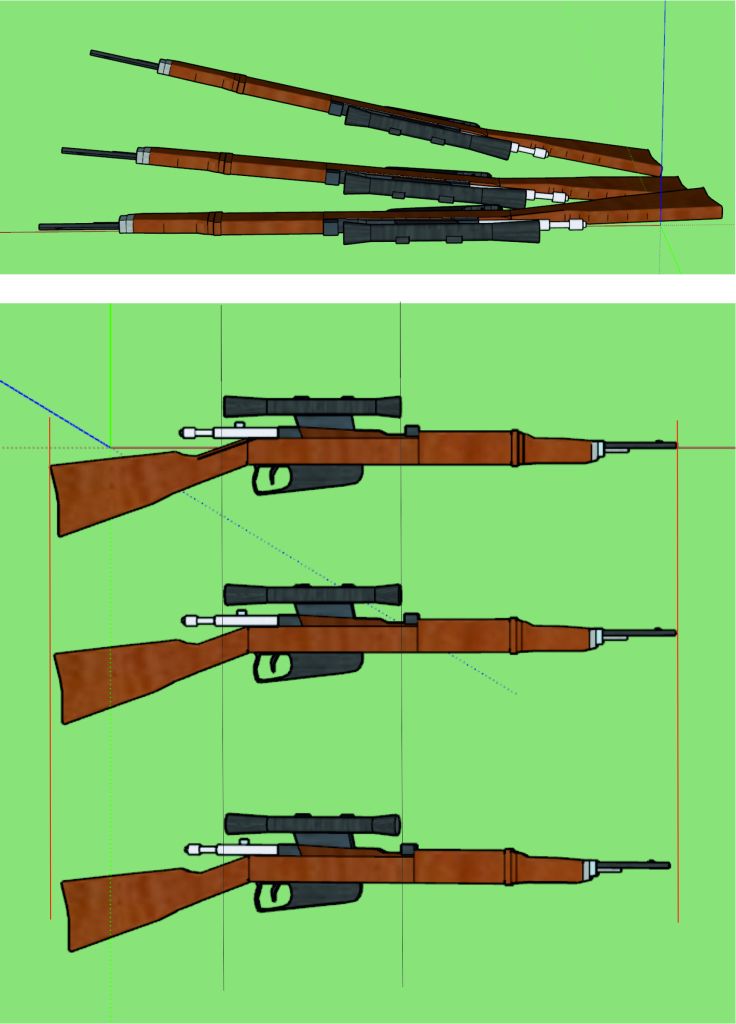
Figure 2: The flat and the most inclined rifle from Figure 1 were equalised based on the length of scopes. Please note the locations of the tips of butts in both rifles.
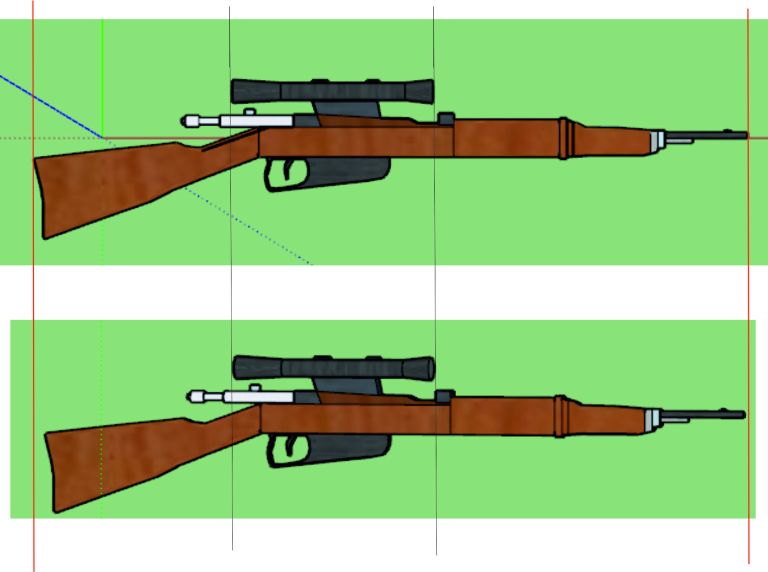
-
Alberto:
did you also consider in your example the location of the scope on an inclined rifle? The center part of the rifle, the fulcrum, will remain relatively unchanged relative to a perfectly vertical (or horizontal) rifle, while the butt and the tip of the barrel would be either further away or closer relative to a perfectly vertical (horizontal rifle). Thus, the error will be observed in the most proximal and distal parts of the rifle. If you equalise the lengths of scopes of one and the same rifle taken from two different angles, the mismatch would be most apparent at the tips of the inclined rifle whilst the scope, since it is at the center of the rifle, will be comparatively unaffected.
-
Chris,
thanks for the challenge and for kindly answering it yourself. Frankly, I have studied neither Towner's nor Z-film to the great detail which would allow me to spot missing frames right away.
Mr. Myers's synchronisations of various assassination films was a good achievement, and something we can start with. It is the time now to offer corrections to Mr. Myers's timelines which may contain flaws. The missing frames in Towner's film is obviously something which Mr. Myers has overlooked or underestimated. Good spot.


G. Gordon Liddy and Marathon Oil—1962 to 1963
in JFK Assassination Debate
Posted · Edited by Andrej Stancak
I have enquired about the "moving to Baltimore area" puzzle with the LN classics, "Marina and Lee" by Priscilla Johnson-McMillan and "Case Closed" by Gerald Posner. Posner in a slavery manner follows Jonson-McMillan's reconstruction of the weeks after the infamous radio broadcast in August and before Lee's alleged trip to Mexico City; the same statements, the same chronology are given in both books. Although both sources did mention the letters to Arnold Johnson, none of these authors bothered to address the puzzling reference to moving to "Baltimore area".
Not knowing about Nagell's information about a possible assassination plan for late September in Washington, DC and using only the LN literature and the Warren Report, one would be left with an interpretation that Lee had mentioned the Washington/Baltimore as the place to where he would move with his family in October, to cover up purchasing air tickets for a long flight; a long-distance flight was necessary, according to Lee's analyses, to hijack a plane in New Orleans which would be able to land at Havana. Facing Marina's opposition, Lee agreed he would get to Cuba legally. This switch of plans from hijacking a plane to travelling to Mexico happened abruptly during about the first week of September. Moving to Washington, DC/Baltimore area was not necessary in this new plan any longer as it was not necessary to buy any air tickets. This explanation sounds crazy, indeed.
Dick Russell's explanation, astutely quoted by David, gives more sense to the CTers. However, it assumes that Lee was quite an active player in the assassination plot and certainly in the know, which I am not sure it was really the case.
I wonder if we ever get to the bottom of the enigmatic reference to moving to Washington, DC/Baltimore in October which seems had briefly enticed Lee's mind.